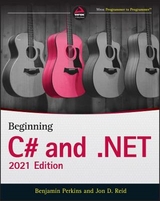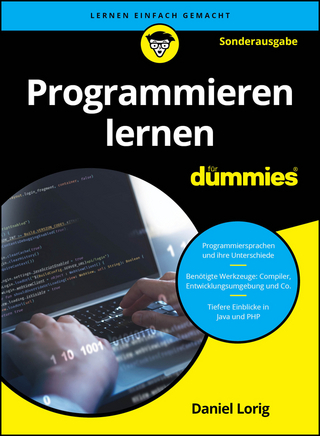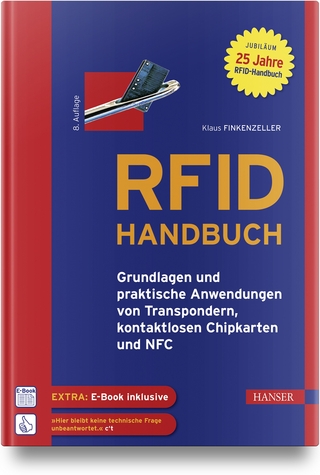
Beginning C# 7 Programming with Visual Studio 2017
John Wiley & Sons Inc (Verlag)
978-1-119-45868-5 (ISBN)
- Titel erscheint in neuer Auflage
- Artikel merken
Beginning C# 7 Programming with Visual Studio 2017 is the beginner’s ultimate guide to the world’s most popular programming language. Whether you’re new to programming entirely, or just new to C#, there has never been a better time to get started. The new C# 7 and Visual Studio 2017 updates feature a number of new tools and features that streamline the workflow, simplify the code, and make it easier than ever to build high-quality apps. This book walks you through everything you need to know, starting from the very basics, to have you programming in no time. You’ll learn about variables, flow control, and object oriented programming, then move into Web and Windows programming as well as databases and XML. The companion website provides downloadable code examples, and practical Try It Out sections provide explicit, step-by-step instructions for writing your own useful, customizable code.
C# 7 can be used to build Windows applications, program Windows 10, and write Web apps when used alongside ASP.NET. With programming skills becoming de rigueur in fields far beyond the tech world, C# 7 is a great place to start building versatile, helpful skills. This book gets you started quickly and easily with instruction from a master-team of C# programmers.
Learn how to program using the world’s leading programming language
Build smarter, faster apps using the latest features in C# 7 and Visual Studio 2017
Find and fix bugs sooner, saving headaches down the line
Integrate with all .NET Core, Azure applications, cloud services, Docker containers, and more
The world of programming can seem intimidating to a beginner, and the prospect of learning a whole new “language” can seem daunting. Beginning C# 7 Programming with Visual Studio 2017 demystifies the process and shows you how to bring your ideas to life.
About the authors Benjamin Perkins is a Sr. Escalation Engineer at Microsoft. His experience includes designing, developing, deploying, administering, and managing enterprise-level IT solutions. Jacob Vibe Hammer helps develop solutions for the health care industry as a Senior Software Engineer at Systematic in Denmark. He has co-authored a number of .NET books and works with numerous Microsoft technologies. Jon D. Reid is a Product Solution Manager in Research and Development at IFS AB, specializing in Field Service Management using C# and .NET. Visit us at wrox.com for free code samples.
Introduction xxi
Part I: The C# Language
Chapter 1: Introducing C# 3
What Is the .NET Framework? 4
What Is C#? 9
Visual Studio 2017 11
Chapter 2: Writing a C# Program 15
The Visual Studio 2017 Development Environment 16
Console Applications 21
Desktop Applications 26
Chapter 3: Variables and Expressions 33
Basic C# Syntax 34
Basic C# Console Application Structure 36
Variables 38
Expressions 46
Chapter 4: Flow Control 59
Boolean Logic 60
Branching 65
Looping 72
Chapter 5: More About Variables 83
Type Conversion 84
Complex Variable Types 91
String Manipulation 109
Chapter 6: Functions 117
Defining and Using Functions 118
Variable Scope 131
The Main() Function 138
Struct Functions 141
Overloading Functions 142
Using Delegates 144
Chapter 7: Debugging and Error Handling 149
Debugging in Visual Studio 150
Error Handling 167
Chapter 8: Introduction To Object-Oriented Programming 179
What Is Object-Oriented Programming? 180
OOP Techniques 186
OOP in Desktop Applications 196
Chapter 9: Defining Classes 203
Class Definitions in C# 204
System. Object 209
Constructors and Destructors 211
OOP Tools in Visual Studio 216
Class Library Projects 222
Interfaces Versus Abstract Classes 226
Struct Types 228
Shallow Copying Versus Deep Copying 230
Chapter 10: Defining Class Members 233
Member Definitions 234
Additional Class Member Topics 244
Interface Implementation 249
Partial Class Definitions 252
Partial Method Definitions 253
Example Application 255
The Call Hierarchy Window 265
Chapter 11: Collections, Comparisons, and Conversions 269
Collections 270
Comparisons 292
Conversions 313
Chapter 12: Generics 319
What Are Generics? 320
Using Generics 321
Defining Generic Types 339
Variance 353
Chapter 13: Additional C# Techniques 359
The :: Operator and the Global Namespace Qualifier 360
Custom Exceptions 361
Events 363
Expanding and Using CardLib 375
Attributes 384
Initializers 386
Type Inference 392
Anonymous Types 394
Dynamic Lookup 398
Advanced Method Parameters 402
Lambda Expressions 409
Part II: Windows Programming
Chapter 14: Basic Desktop Programming 425
XAML 426
The Playground 429
Control Layout 441
The Game Client 452
Chapter 15: Advanced Desktop Programming 479
Creating and Styling Controls 480
WPF User Controls 485
The Main Window 499
Putting It All Together 504
Part III: Cloud and Cross-Platform Programming
Chapter 16: Basic Cloud Programming 533
The Cloud, Cloud Computing, and the Cloud Optimized Stack 534
Cloud Patterns and Best Practices 537
Using Microsoft Azure C# Libraries to Create a Storage Container 538
Creating an ASP.NET 4.7 Web Site That Uses the Storage Container 548
Chapter 17: Advanced Cloud Programming and Deployment 559
Creating an ASP.NET Web API 560
Deploying and Consuming an ASP.NET Web API on
Microsoft Azure 564
Scaling an ASP.NET Web API on Microsoft Azure 572
Chapter 18: .NET standard and .NET Core 579
Cross-Platform Basics and Key “Must Know” Terms 581
What Is .NET Standard, and Why Is It Needed? 583
Referencing and Targeting Frameworks 587
What is .NET Core? 588
Building and Packaging a .NET Standard Library 596
Building a .NET Core Application with Visual Studio 602
Porting from .NET Framework to .NET Core 605
Chapter 19: ASP.NET and ASP.NET Core 609
Overview of Web Applications 610
Which ASP.NET to Use and Why 611
Using ASP.NET Web Forms 620
Creating ASP.NET Core Web Applications 627
Part IV: Data Access
Chapter 20: Files 641
File Classes for Input and Output 642
Streams 647
Monitoring the File System 664
Chapter 21: XML and JSON 673
XML Basics 674
JSON Basics 674
XML Schemas 675
XML Document Object Model 677
Converting XML to JSON 689
Searching XML with XPath 691
Chapter 22: LINQ 697
LINQ to XML 698
LINQ Providers 704
LINQ Query Syntax 705
LINQ Method Syntax 709
Ordering Query Results 712
Understanding the orderby Clause 713
Querying a Large Data Set 714
Using Aggregate Operators 717
Using the Select Distinct Query 720
Ordering by Multiple Levels 723
Using Group Queries 725
Using Joins 727
Chapter 23: Databases 731
Using Databases 731
Installing SQL Server Express 732
Entity Framework 732
A Code First Database 733
But Where Is My Database? 740
Navigating Database Relationships 742
Handling Migrations 749
Creating and Querying XML from an Existing Database 750
Part V: Additional Techniques
Chapter 24: Windows Communication Foundation 761
What Is WCF? 762
WCF Concepts 763
WCF Programming 768
Chapter 25: Universal Apps 793
Getting Started 794
Windows Universal Apps 795
App Concepts and Design 796
App Development 797
Common Elements of Windows Store Apps 816
The Windows Store 818
Appendix: Exercise Solutions 821
Index 865
| Erscheinungsdatum | 16.04.2018 |
|---|---|
| Verlagsort | New York |
| Sprache | englisch |
| Maße | 188 x 230 mm |
| Gewicht | 1270 g |
| Themenwelt | Mathematik / Informatik ► Informatik ► Programmiersprachen / -werkzeuge |
| ISBN-10 | 1-119-45868-4 / 1119458684 |
| ISBN-13 | 978-1-119-45868-5 / 9781119458685 |
| Zustand | Neuware |
| Informationen gemäß Produktsicherheitsverordnung (GPSR) | |
| Haben Sie eine Frage zum Produkt? |
aus dem Bereich



